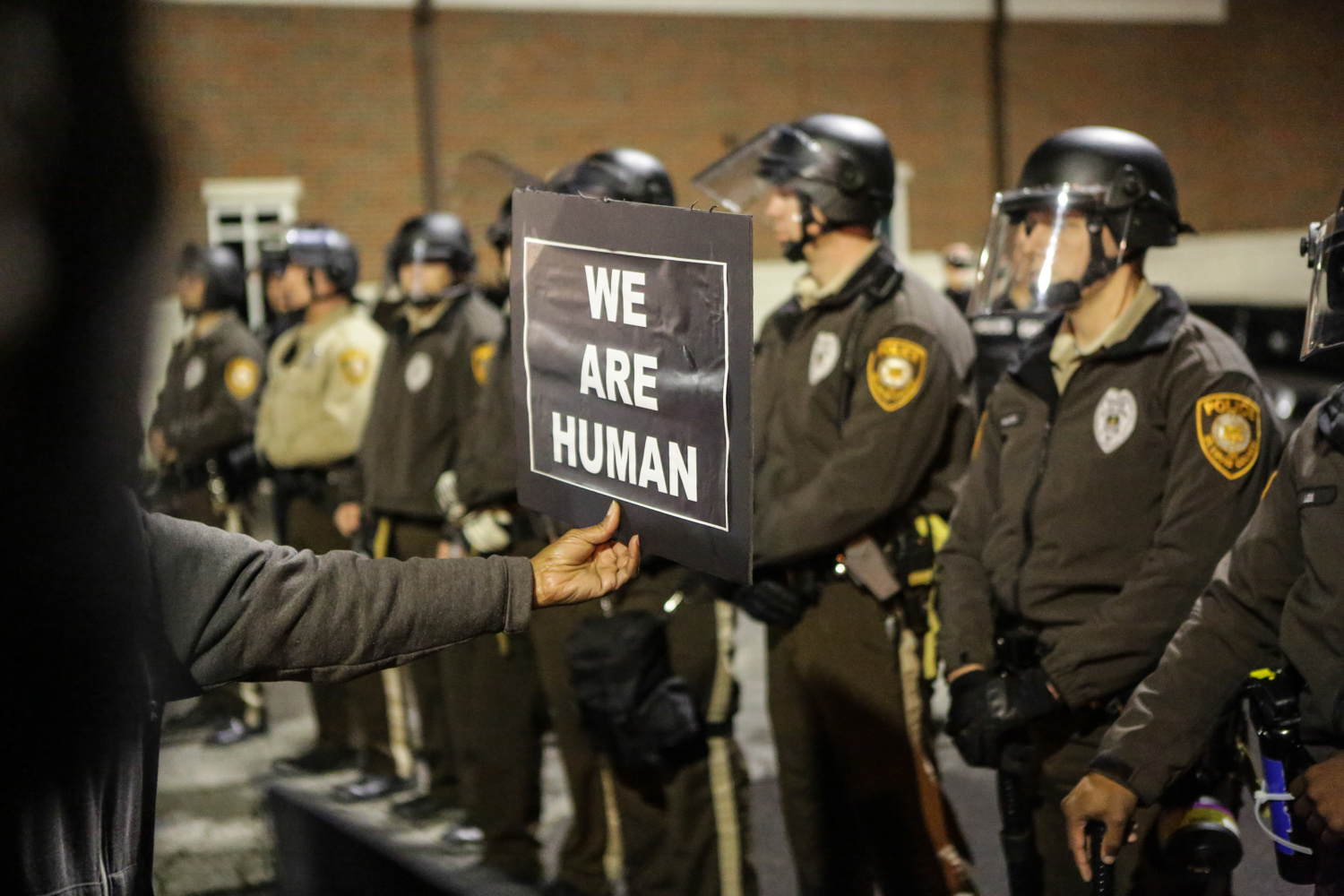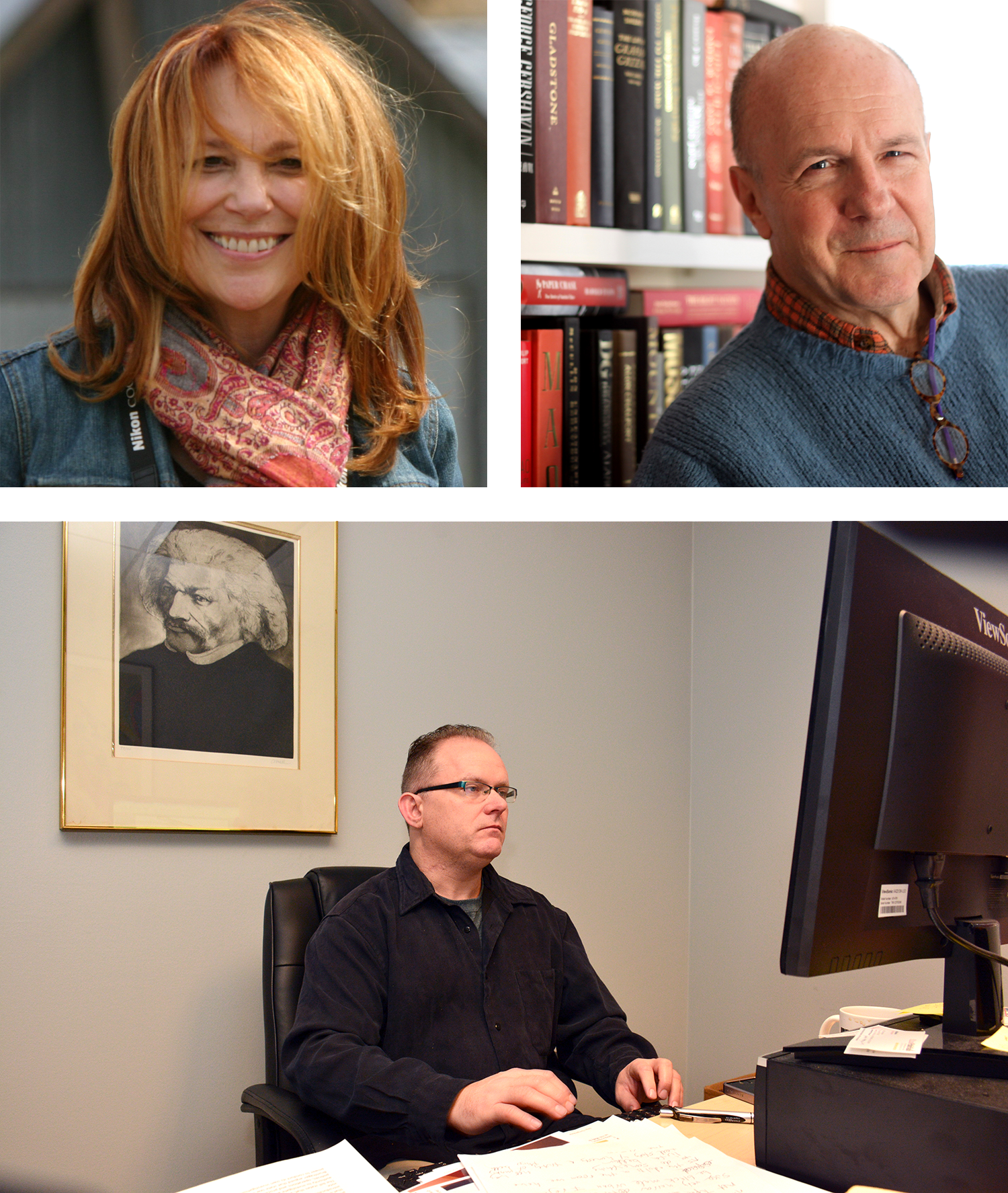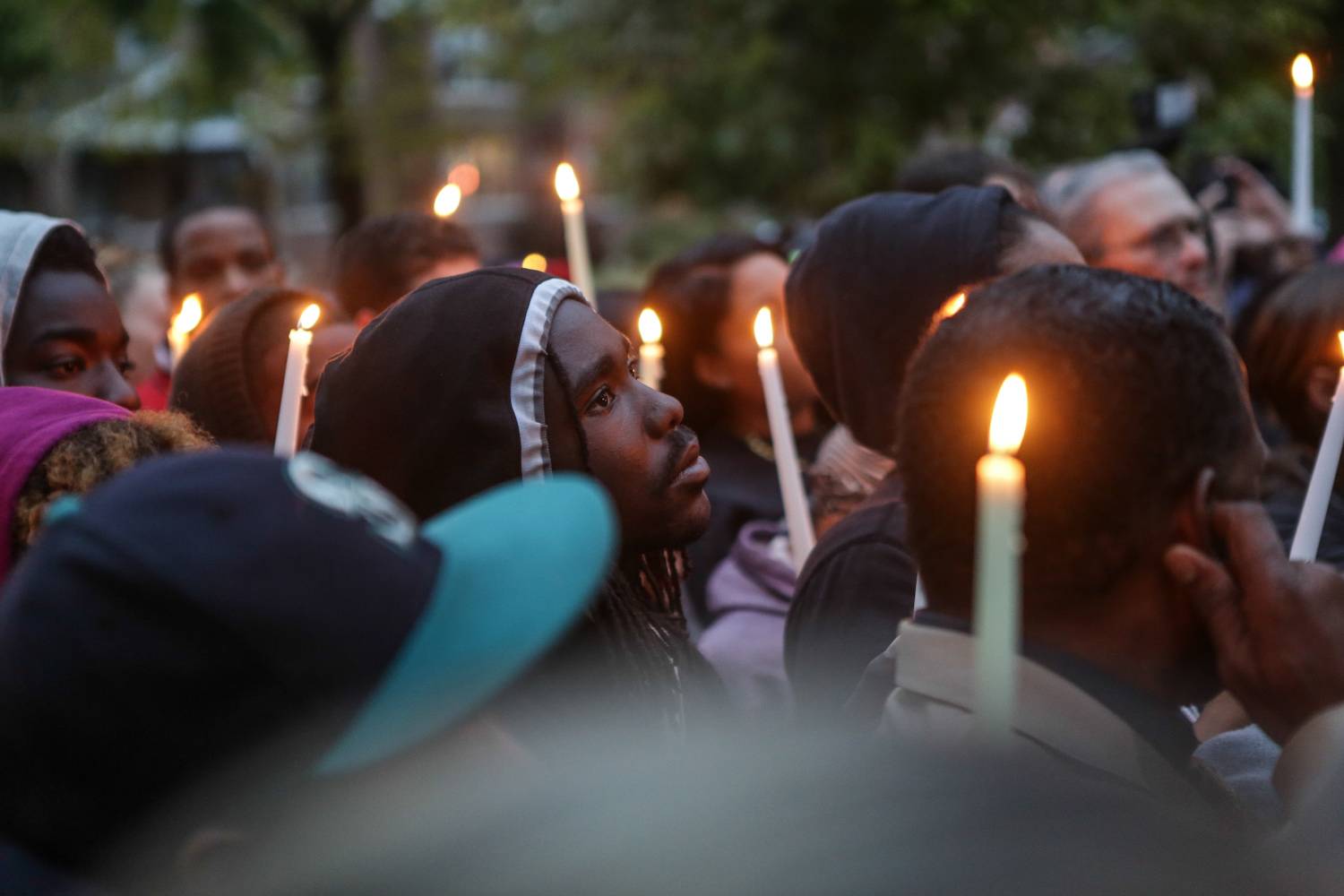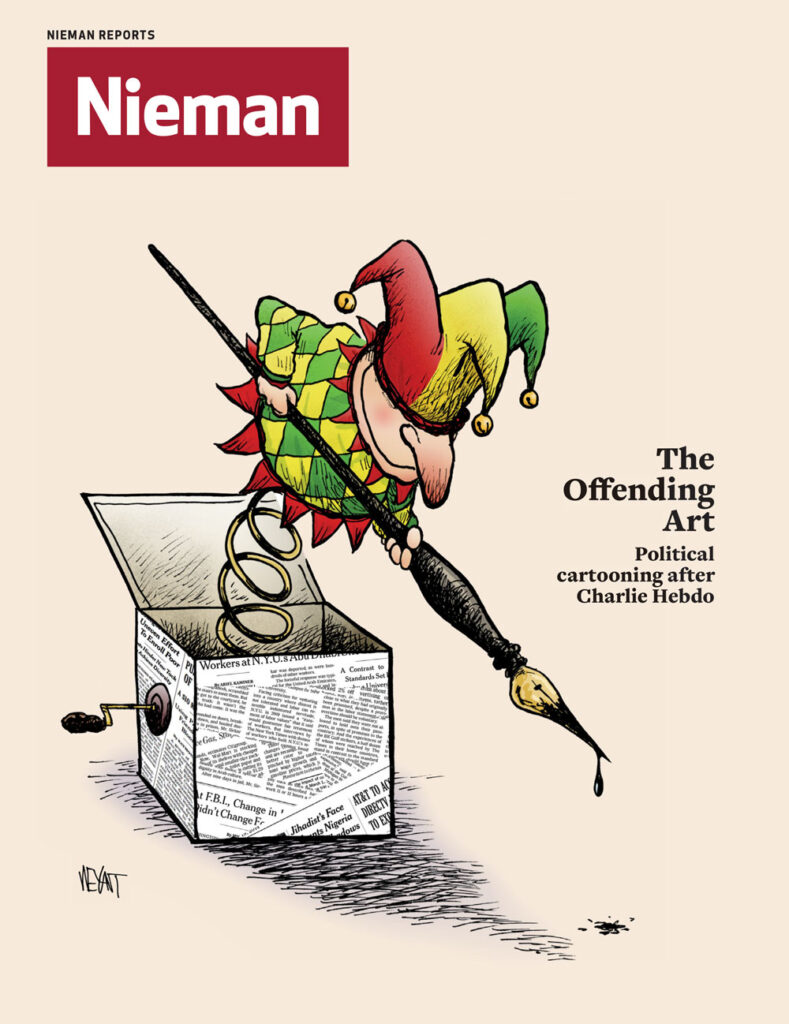Intermission was over and the house lights were about to go down for the St. Louis Symphony Orchestra’s performance of Brahms’s “German Requiem.” It was Saturday, October 4, 2014. Rebecca Rivas, a reporter for The St. Louis American, was in the audience, her camera ready. She’d been tipped off by a source active in the protests that had erupted after an unarmed teenager was shot and killed by a police officer in nearby Ferguson.
Singing began, but it wasn’t coming from the stage. A man in the rear of the hall sang, in a clear, strong voice: “What side are you on, friend, what side are you on?” Then a woman stood, a few rows away, and joined in. One by one and then more each moment, some 50 people rose, singing “Justice for Mike Brown is justice for us all.” Some in the audience clapped, as did some of the musicians; other audience members looked stunned. Rivas captured it and posted a video on the American’s website. It was picked up by the St. Louis Post-Dispatch, NPR, CNN, and MSNBC, among other outlets.
Rivas and her colleagues on the weekly newspaper’s tiny staff had an advantage over the journalists who flocked to Ferguson in the wake of the shooting of Michael Brown on August 9, 2014. The African-American community of greater St. Louis already knew and trusted the paper, which has covered that community since 1928. Missouri State Senator Maria Chappelle-Nadal, who represents Ferguson, calls The St. Louis American “the only source of information we have that’s balanced and of interest.” And Adolphus M. Pruitt II, president of the St. Louis City chapter of the National Association for the Advancement of Colored People, says, “They cover those things that are truly emotionally charged for the black community, in ways that go into detail on the subject and the issue.”
In addition to its news reports, editorials, and widely read “Political Eye” column, the American’s coverage of churches, community organizations, and social events has helped keep the African-American community tied together as it dispersed from the central city to the suburbs, says University of Missouri journalism professor Earnest L. Perry Jr. “Say you grew up in one part of St. Louis that was heavily African-American and moved to another part that wasn’t, you’d still have a link back to that community” through the weekly paper, Perry says.
That kind of connection is a hallmark of the community journalism that weeklies provide. Often, local newspapers are the top source for news about a community, a source that has grown in importance as regional papers have pulled back from covering outlying communities over the past 15 years. Weeklies with a strong editorial voice bring communities together—or stir debate—over issues of great local import. Some weeklies, like the American, cover not only a geographical community but also a “community of interest,” the term of art for groups with a shared orientation, whether racial, ethnic, occupational, or otherwise.
Related Article
“Four Lessons from Buying and Running the Outer Banks Sentinel”
By Mark Jurkowitz
Often overlooked in discussions of the future of newspapers, U.S. community weeklies still matter to millions of readers. The total circulation of the nation’s 7,000 non-daily community newspapers is about 65.5 million, according to a 2010 National Newspaper Association (NNA) study. Seven out of 10 weeklies have a circulation of less than 15,000, according to NNA figures.
While major daily papers have expanded their online presence, there is a robust debate as to whether, or how quickly, weeklies should attempt to move their communities online. Penelope Muse Abernathy, a former newspaper executive and author of the 2014 book “Saving Community Journalism,” argues for now. But sentiment on the 265-member listserv of the International Society of Weekly Newspaper Editors runs strongly in favor of maintaining an emphasis on print for reasons of revenue and community service.
“The weekly newspaper business is the healthiest part of the American newspaper business,” says Al Cross, director of the Institute for Rural Journalism and Community Issues at the University of Kentucky. Yet he sees trouble ahead due to the growing role that communities of interest play in people’s lives through social media. “As we spend more time with communities of interest, do we spend less time with communities of place, and does that reduce the interest in, and demand for, news of that place?” he asks. “I think it does.”
There is a robust debate as to whether, or how quickly, weeklies should attempt to move their communities online
In that sense, The St. Louis American may be luckier than most weeklies because of its dual role as a local paper and as one that covers a community of interest. It engages its readers not only with its 70,000-circulation paper, which is free on newsstands, but also through its website and active presence on social media.
Chris King, managing editor of the American, declines to discuss the paper’s finances in detail but calls the paper “a struggling family-owned business” and allows that owner and publisher Donald M. Suggs “pitches in on payroll.” Its small editorial staff—seven full-timers plus two part-timers—produces up-to-the minute Ferguson coverage online, though some stories never see print as events outpace them.
Not surprisingly, Martin Luther King Jr. Day, Jan. 19, was a charged holiday in St. Louis. Both the American and The St. Louis Post-Dispatch covered it closely but with significant differences. The American’s coverage included a detailed nearly 1,900-word account of tensions throughout the day. Those tensions, between people who wanted to focus on Dr. King’s legacy and protesters, many of them younger, who wanted to honor his revolutionary spirit, resulted in a chaotic confrontation on a state university campus within city limits. The Post-Dispatch ran a 900-word story.
Margaret Wolf Freivogel, a longtime Post-Dispatch staffer who now runs the newsroom at St. Louis Public Radio, which has a content-sharing agreement with The American, notes that The American considers itself an advocate for the community it covers. King freely admits this. “We can count on everyone else to do all the bad news about the black community,” he says. “We will let a lot of negative stories pass or do them in brief only.”
Freivogel adds: “I have a very high level of trust in their standards and in their accuracy, so it’s not like they’re just purely an advocacy organization. They’re very much a news organization.”

Advocacy is often integral to the sense of mission at weekly newspapers, such as The Mountain Enterprise, based in Frazier Park, California. Though the Enterprise covers nine hamlets in a remote area 75 miles from Los Angeles, Patric Hedlund, a documentary filmmaker turned newspaper co-owner and editor, says she never runs short of news and intrigue. Hedlund shares many instances in which her paper’s coverage made a major splash—how conflicts of interest among local government officials were uncovered, how community reporters she coached found evidence that proposed housing developments would deplete the area’s water supply, how neighbors call her to witness and record events that no one else will cover, whether it’s “sheriff’s deputies running down the street with drawn guns” or a crew cutting down 300- and 400-year-old trees that the community had thought were protected.
Advocacy is often integral to the sense of mission at weekly newspapers
A newspaper like The Mountain Enterprise “belongs to the community,” Hedlund says, and the experience of having her work read each week by people she knows well has been profound after a career spent producing documentaries in Russia, Ukraine, Germany, and across the U.S. “Working on a national or international basis is not as personal as working in a community environment,” she says. “Every single thing you say here has a ripple effect on your neighbors.”
And in a region where wealthy, well-connected outsiders wield considerable influence over the future of Frazier Mountain communities, the Enterprise amplifies the voices of those locals who stand up for themselves. “People are trying to have a voice, and when there are issues, to have a way to articulate and investigate what those issues are,” she says. Hedlund has held trainings and workshops for area residents, “helping people develop their capacities to be good reporters of their own lives,” she calls it. One such reporter was soil scientist Doug Peters, whose first involvement with the paper was writing letters to the editor opposing the proposed Frazier Park Estates development. Subsequently, on the paper’s behalf, Peters read 15 volumes of environmental impact reports for that development and two others. With Peters’ help, the Enterprise revealed what had been buried in the developers’ report: groundwater levels at the proposed development site had fallen precipitously in the previous decade.
“The whole experience was satisfying,” Peters says, “as I saw the results of my research and education published and appreciated by readers. I was able to get across my message to the community that adequate water supply for the development was doubtful.” Working with Hedlund wasn’t always easy, he said: “It got more challenging [as she] demanded more and more supporting information. It became downright grueling with e-mails and phone calls as deadlines approached.”
In the case of Frazier Park Estates, public hearings amid continued coverage by The Mountain Enterprise led the county planning department to force the developer to redo its submission. The battle culminated in a decision by the state parks department to acquire the land in question.
“In the end,” says soil scientist Peters, “a really bad project was killed and I’m glad to have helped.”
Hedlund gives her readers much of the credit. Community members made 100- to 120-mile round trips to show up and testify at hearings again and again, and raised money to hire a lawyer. A California Superior Court judge ruled for the community plaintiffs, and the developer dropped his appeal. “By seeing their story considered important enough, seeing it on the front page—and it never faded—people were able to carry forward with their needs,” she says. In 2007, The Mountain Enterprise’s Frazier Park Estates coverage won the California Newspaper Publishers Association’s first-place prize for environmental reporting.
Hedlund and her husband initially lavished their production expertise on the paper’s free website, but then their print circulation dropped, putting an end to that. “The better our website became, the more our street sales diminished,” Hedlund says. “The numbers kept telling us that the print product”—the paper has a paid circulation of 2,550—“is still the bread and butter for now, and it is vital to respect that fact.” Now, the website offers breaking news for free, but everything else is behind a paywall. Street sales and subscribers have increased and ad inches “are holding steady,” Hedlund says.

It’s the rare newspaper that doesn’t depend heavily on advertising, but one such paper exists in the foothills of the Berkshire Mountains in Massachusetts, just 20 miles east of the New York border. The idea for The Sandisfield Times was born at a dinner party in 2009 among former weekenders who now live full time in the rural community. At first, the monthly paper had no ads, relying on donations. To this day, most of its staff is volunteers. In the beginning, none of them wanted to sell ads; but as its audience grew, local businesses asked for the opportunity to reach readers. The paper, which became a nonprofit in June 2013 and prints 1,000 copies a month, pays its sole employee, a graphic designer, with its advertising income, and uses donations from its annual appeal to cover other costs. Its website is free, and it has no social media presence.
The 53-square-mile Sandisfield has no village green, town center, general store, coffee shop or diner; in short, there are few places to hang out and gather local tidings. Before the birth of the Times, “it was really hard to find out when the dump hours were, for example,” says Setsuko Winchester, a former producer of NPR’s now-defunct “Talk of the Nation” and the paper’s first photo editor. Her husband, journalist and author Simon Winchester (“The Professor and the Madman,” “Krakatoa,” “The Map That Changed the World”) was its prime mover and founding editor.
Winchester, a tall, smiling Englishman with a direct gaze and approachable manner, has lived full time in Sandisfield, population about 900, since 2002. He works from his studio, an 1812 granary with windows that wash his two-story work area in light. The main elements of the décor are framed maps, photographs and books—thousands of books, lining shelves and piled everywhere. He came up with the newspaper’s mottoes (“Tribunus Plebis,” or “The Guardian of the People,” and “Reliable. Regular. Relevant.”), edited the paper for its first year, and still writes for it.
Longtime Sandisfield residents, many of them hardworking farmers, found little to like in the paper at first. But over time, that has changed.
With Manhattan less than a three-hour drive from Sandisfield, “you’re going to have the city folks that are going to come in and want to change everything,” says Barbara Riiska, an orchard owner who was born one town over and married into an old-time Sandisfield family. “‘Wait a second: What did you move out here for in the first place?’” Now, though, she’s glad she can follow what happens at town meetings. The largest paper in the region, the daily Berkshire Eagle, “has no idea that we exist,” she laments.
A relative, A.J. Riiska, says that at first, he felt the paper was “kind of all about what the summer people were interested in. They didn’t even cover the Memorial Day parade” in 2010, he says in disgust. Over time, however, the paper has earned Riiska’s grudging respect. He reads it regularly. “It’s not a bad old newspaper now,” he says.
Winchester acknowledges that initially, “we were widely condemned as being elitist and further dividing the community,” but says that has changed, “grudgingly, slowly—not that we tried to campaign, but simply because we covered the town rather well.”
The lead story in the paper’s inaugural issue in April 2010 launched the newspaper’s campaign to do something about two ruined houses along a main road, houses “out of a ’50s horror film,” Winchester says. The houses were eventually demolished, and Winchester counts this as the paper’s first success.
The Sandisfield Times has continued to crusade on local controversies, but it also routinely publishes stories about town officials and the town budget, the state of town roads, obituaries, columns on gardening, and photos of the community as the seasons change. Its first issue had eight pages. Now, it regularly fills 20, covering not just the Select Board but also Sandisfield’s finance, strategic planning, technology and cemetery committees, its board of health, and the local arts center. It’s a robust local report in a place that lacked anything like it.
“The paper has been able to bring light into what’s going on in town government,” says Patrick Barrett, a high school history teacher and Select Board member. In one instance, a member of the town’s finance committee wrote a letter in which she detailed her grievances against the Select Board. In the next issue, Barrett responded point by point, acknowledging the justice of some of her zingers while clarifying the context of others. “It’s been a vehicle for me to set the record straight,” Barrett says.
In the epilogue to his 2013 book, “The Men Who United the States,” about the knitting together of a disparate population, Winchester writes, “The paper is now popular, needed, and ceaselessly written to, and it’s brought to Sandisfield something the village has never truly enjoyed in all of its 250 years of incorporated existence: a sense of community, a common sense of unity.”
And that sense of unity may be, in the end, what accounts for the resilience of the community newspaper. "In many towns in this country, people don’t say, 'I read that in the paper'; they say, 'I read that in our paper,'" says Al Cross, director of the Institute for Rural Journalism and Community Issues at the University of Kentucky. “This shows that people have a very strong identity with their local newspaper as [their] tribune and advocate, and also as a journalistic enterprise that holds up a mirror and doesn’t sugarcoat things.”




